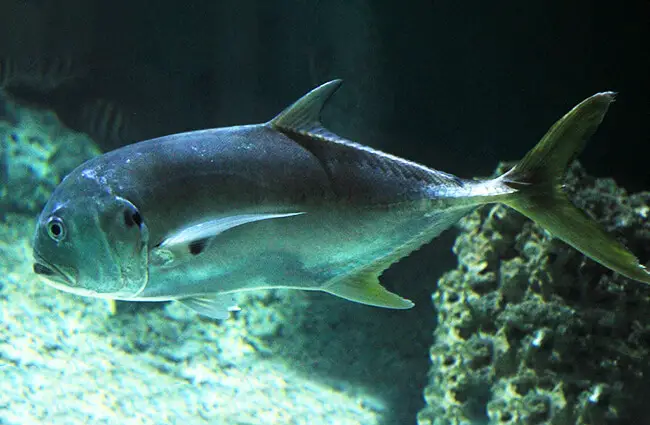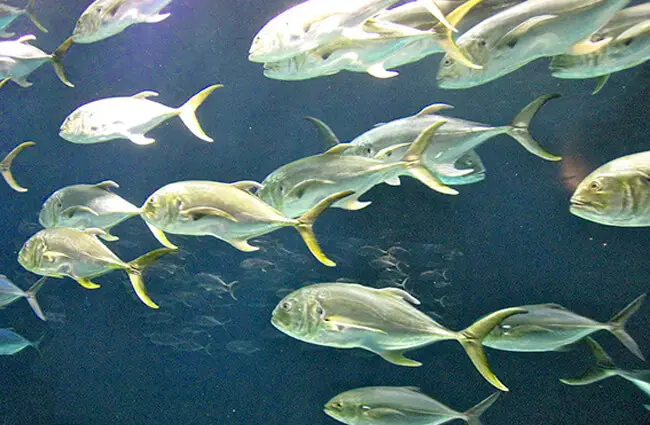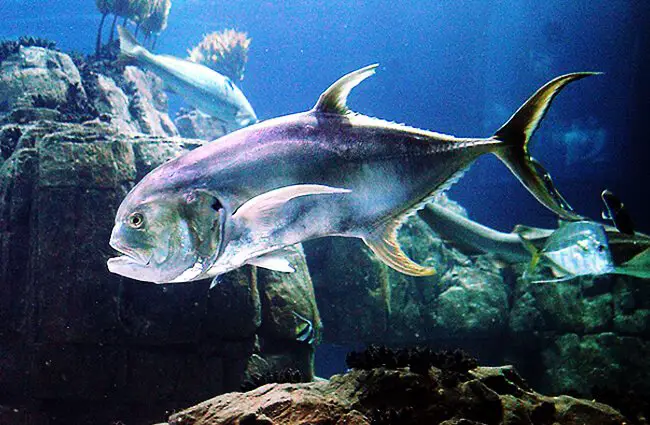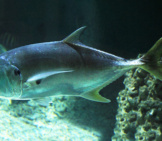People refer to a wide variety of different fish species as Jack Fish, or simply “Jacks.” Researchers place all of the various species in the Carangidae family. Other members of Carangidae include the pompano, lookdown, trevally, and more.
However, when people refer to a “jack” or “Jack Fish,” they typically mean the Crevalle jack. For this reason, we will focus primarily upon this species. Read on to learn about the Jack Fish.
Description of the Jack Fish
This species has a silver colored body, broad head, and tinges of yellow scales on its back, fins, and tail. The dorsal fin upon its back points backward towards its forked tail. Adults reach sizes of up to 4 ft. long and 70 lbs. However, average individuals typically measure no more than 2 ft. long.
Interesting Facts About the Jack Fish
These fish have a number of interesting traits and adaptations. Learn more about what makes them unique, below.
- Commercial Collection – People capture this species in commercial fisheries and raise them in aquaculture. Fishermen use several different types of nets and fishing lines to capture these fish. Sport fishermen also target this powerful species recreationally.
- Jack Fish, Jack Quality – Even though people catch thousands upon thousands of pounds of this fish for commercial sale, you don’t commonly find a jack filet on a dinner plate. This is because their meat has somewhat poor quality.
- Fishy Product – Instead of eating this fish’s meat as filets, people often use the species in fish oil, fishmeal, and similar products. However, some fishermen also sell better-quality meat fresh or frozen.
Habitat of the Jack Fish
This species lives in several different types of habitats. You can find them in estuaries, bays, reefs, seagrass beds, sandy flats, and more.
They swim in waters offshore as well as coastal regions and into brackish habitats where salt and freshwater mix. Though offshore populations move into deeper waters, they generally do not range exceptionally far from the coastlines.
Distribution of the Jack Fish
You can find this species throughout the coastal regions of the Atlantic Ocean. Its range extends along both the eastern and western coastlines in the Atlantic.
In the eastern Atlantic, you can find this species along the coast of northern and central Africa. In the western Atlantic, the populations range along the coasts of North, Central, and South America.
Diet of the Jack Fish
This fish has carnivorous feeding habits, which means it preys on other animals. It has a primarily piscivorous diet because it eats fish and other similar seafood. Younger fish, being smaller, hunt for smaller prey. Adults can hunt larger fish with their increased size. They also eat squid, shrimp, crabs, and more.
Jack Fish and Human Interaction
Humans interact with this species quite frequently. Fishermen often target this fish in both commercial and recreational settings. In sport fisheries, people target this species for its powerful swimming. Where some commercial fisheries face population decline, this species has strong numbers.
The IUCN lists this species as Least Concern.
Domestication
Humans have not domesticated this fish in any way.
Does the Jack Fish Make a Good Pet
No, these creatures do not make good pets. They reach sizes much too large to easily house in a home aquarium.
Jack Fish Care
Some commercial aquariums keep this fish in their collections. To meet their social needs, they house them in schools, usually in large pelagic-style tanks with lots of space to swim.
In these large tanks, the Jacks also share their space with other, similar-sized species that they also coexist with in the wild. Aquarists feed them a diet of fish, shrimp, squid, shellfish, and more.
Behavior of the Jack Fish
The behavior of this species varies based on the age of the fish and the season. Younger fish spend their time in estuaries and other sheltered habitats to avoid predators. Adults live in several different types of habitats. The groups, known as schools, undergo seasonal migrations, with younger fish taking different migration patterns.
Reproduction of the Jack Fish
This species reproduces via spawning. The breeding season varies based on the region that the fish lives in. When it comes time to spawn, the females release their eggs into the water and the males fertilize the eggs outside of the body. A single female can produce up to a million eggs.
After fertilization, both parents show no investment in their offspring in any way. The eggs float in the water column until they hatch, as do the larval young. As they reach their juvenile phase, the young move to shore and sheltered habitats.













![Red Angus Closeup of a beautiful Red Angus cowPhoto by: U.S. Department of Agriculture [pubic domain]https://creativecommons.org/licenses/by/2.0/](https://animals.net/wp-content/uploads/2020/03/Red-Angus-4-238x178.jpg)












![Red Angus Closeup of a beautiful Red Angus cowPhoto by: U.S. Department of Agriculture [pubic domain]https://creativecommons.org/licenses/by/2.0/](https://animals.net/wp-content/uploads/2020/03/Red-Angus-4-100x75.jpg)

